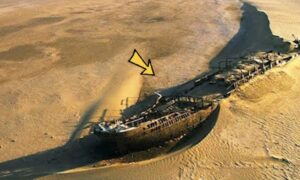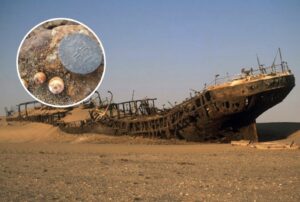
One of the most fascinating archeological discoveries of the past few years is the discovery of a ship that went missing five centuries ago in a southwest African desert and had gold coins on board.
On Friday, March 7, 1533, a Portuguese ship sailed out of Lisbon. Its whereabouts was unknown until 2008, when its bones were found in Namibia’s desert near the coast while conducting diamond mining.
It was headed for India when a strong storm flipped it over, stealing valuables including copper and gold ingots. On board the ship, tens of thousands of pounds of copper ingots and two thousand pieces of pure gold were found, nearly all of them undamaged.

In addition to cash, the ship found in the desert held a significant amount of cargo.
Dr. Noli, principal archaeologist at the Southern Africa Institute of Maritime Archaeological Research, says that finding a shipwreck is not surprising because storms have been known to lash the shoreline recently.
But after only a week of digging, a gold-filled treasure box was discovered, and the coins within indicated that it had belonged to a Portuguese ship that had vanished in 1533.
The ship was reportedly carried dangerously close to land during a storm off the coast of Namibia, which is thought to be the reason the hull toppled over and struck a rock. It reappeared in the desert as the waters off the shore retreated.
The state of the ship upon finding, with the exception of a few lone bone fragments, indicates that the storm that caused the disaster was exceptionally strong; yet, the lack of human remains indicates that the most of the crew either escaped the wreck or drowned at sea.
Dr. Noli told News Com, Australia, “It adds new meaning to the concept of the ship having been loaded with gold.”
Bronze bowls were found after more research, and the long metal poles were later identified as canons.
In addition to the musket, which they calculated to be at least 500 years old, Dr. Noli’s team also discovered metal shards that suggested a shipwreck was hidden in the sand. Found inside were swords, compass, astrological instruments, guns, and even a time capsule. Coins made of silver were also discovered.
Dr. Noli and other specialists surmise that the ship was traveling from its home port in Lisbon, Portugal, past the southern edge of Africa, and toward Western India based on the contents of the disaster.
This route was frequently used by similar Portuguese ships carrying the same load at the time.
Currently, the most valuable and ancient shipwreck ever found off the Western coast of Sub-Saharan Africa is called the Bom Jesus.
Sperrgebiet, or “forbidden territory,” was the name given to the area where the ship was discovered since hundreds of German prospectors had gone there in search of diamonds.
According to CNN, the facility is still mostly hidden. It is the product of a joint venture between the Namibian government and the diamond corporation DeBeers.
The shipwreck’s remains are currently guarded by mining security and are only open to a select few people. A museum concept has been discussed, but it’s unclear if it will come to pass.





